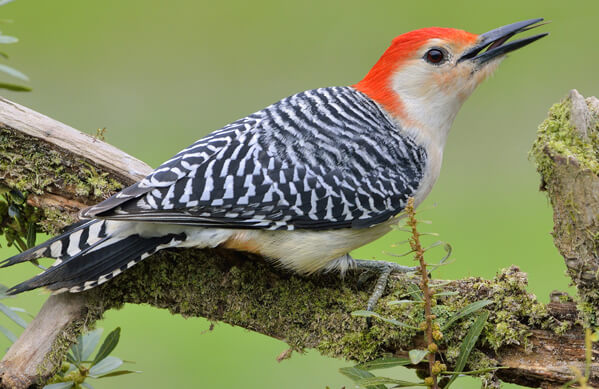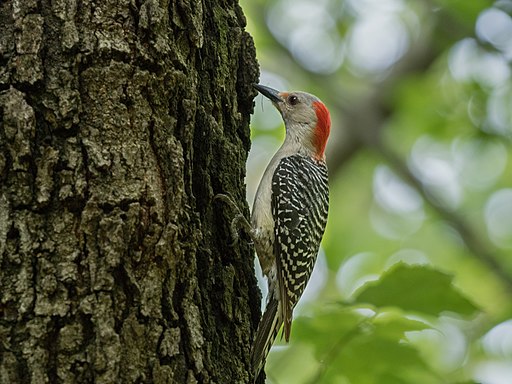Native Woodpeckers in Florida: An Overview to Species and Behaviors
Native Woodpeckers in Florida: An Overview to Species and Behaviors
Blog Article
Woodpeckers: A Comprehensive Overview to Comprehending These Unique Birds
Woodpeckers, with their distinct behaviors and physical characteristics, have long astounded the curiosity of ornithologists and nature fanatics alike. As we check out the elaborate composition, varied types, and environmental value of woodpeckers, a much deeper admiration for these unique birds and the mysteries they hold unravels.

Woodpeckers' Drumming Behavior
Woodpeckers display a rhythmic and exact drumming actions that serves various essential functions in their day-to-day lives. This behavior is largely associated with interaction, territory protection, and foraging. The distinct drumming sound is produced by the rapid pecking of their beaks versus hard surface areas such as tree trunks, branches, and even metal objects.
Interaction is a crucial aspect of woodpecker actions, and drumming plays a significant function in this procedure. Woodpeckers make use of drumming to develop their visibility, draw in friends, and preserve contact with their partners and spawn. The frequency, strength, and period of drumming series communicate certain messages to other woodpeckers in the location.
In addition to communication, woodpeckers utilize drumming behavior for region defense. Woodpeckers in Florida. The loud and repetitive drumming offers as an advising to possible burglars, signaling that the location is currently asserted. By establishing their region with drumming, woodpeckers lower the probability of conflicts over useful resources such as food and nesting websites
Moreover, woodpeckers also employ drumming as a foraging technique. The rhythmic pecking aids them find pests concealing underneath the bark of trees by developing vibrations that interrupt the victim's concealment. This habits showcases the versatility and resourcefulness of woodpeckers in using their drumming abilities for multiple necessary functions.
Unique Adaptations for Tree Climbing
Having mastered the art of drumming to connect, protect territory, and forage, woodpeckers have developed unique adaptations that promote their impressive climbing up capabilities in their arboreal environments. One essential adjustment is their specific feet. Woodpeckers have zygodactyl feet, with two toes pointing ahead and 2 toes aiming backward. This plan offers a solid grasp on the vertical surfaces of trees, allowing them to stick effortlessly while foraging for insects or drumming. Additionally, woodpeckers have rigid tail feathers that serve as a prop to support their bodies as they climb. These tail feathers give security and equilibrium, allowing woodpeckers to steer up tree trunks with accuracy and dexterity.
Additionally, woodpeckers have powerful neck muscle mass and an unique head structure that help in their climbing capacities. Their solid neck muscle mass enable them to swiftly peck at tree bark without experiencing whiplash, while their thick head and tiny mind work as shock absorbers, securing them from the influence of duplicated drumming. These adjustments jointly enable woodpeckers to navigate the vertical globe of trees with efficiency and poise.

Role of Woodpeckers in Environments
By foraging for pests under the bark of trees, woodpeckers assist regulate bug populations, preventing break outs that can harm the total health of the forest. check out this site In addition, woodpeckers produce tooth cavities in trees that serve as critical nesting websites for a selection of various other bird varieties, promoting biodiversity within the ecosystem.
Additionally, the drumming and articulations of woodpeckers play a vital function in interaction and region facility. These noises not only offer to bring in friends however additionally help specify limits in between various woodpecker areas, decreasing disputes and promoting a harmonious conjunction within the woodland community. Generally, the presence of woodpeckers in forest ecological communities highlights their relevance as keystone varieties, influencing the dynamics and operating of these habitats in complex ways.
Anatomy: Specialized Beaks and Feet
In the complex web of forest ecological communities, the specialized beaks and feet of woodpeckers are crucial adjustments that allow them to meet their important environmental roles. Woodpeckers possess one-of-a-kind anatomical functions that are particularly designed to assist them in their foraging and nesting actions.
One of the most unique attribute of woodpeckers is their solid, chisel-shaped beaks. These beaks are completely adapted for boring right into timber to discover insects, larvae, and sap covert underneath the bark of trees. The solid muscular tissues and sturdy structure of their beaks enable woodpeckers to eat a rate of up to 20 times per secondly without creating damage to their skulls.
Additionally, woodpeckers have specialized feet that help in their acrobatic climbing capacities. Their feet have 2 toes aiming forward and 2 toes directing in reverse, providing a solid hold on vertical surfaces (Woodpeckers in Florida). This Full Article special foot plan, in addition to stiff tail plumes that serve as an encouraging prop, enables woodpeckers to stick to tree trunks and branches easily while they search for food or dig deep into nesting tooth cavities
Woodpecker Variety Variety
What factors add to the amazing variety of woodpecker types throughout different habitats and areas? Woodpeckers are a varied team of birds found across various ecosystems worldwide, with over 200 known varieties exhibiting adjustments to different environments. One crucial aspect driving this variety is the availability of appropriate habitats. Woodpeckers have actually evolved to live in a series of atmospheres, from forests and forests to grasslands and deserts, each providing special difficulties that have affected the evolution of unique woodpecker species.
Another adding aspect to woodpecker species diversity is their specialized feeding habits. Various varieties have actually evolved to make use of different food resources, such as insects, tree sap, fruits, and nuts, causing the advancement of certain adaptations in beak shape, dimension, and stamina. These adaptations allow woodpeckers to forage efficiently in their particular habitats, lowering competitors among types and advertising niche distinction. Furthermore, go to the website geographical seclusion and historic factors have actually played a role in forming the circulation and variety of woodpecker species, causing the broad variety of specialized adjustments seen in these interesting birds.

Final Thought
In conclusion, woodpeckers are interesting birds that display unique drumming habits, specialized adjustments for tree climbing, and play essential functions in communities. Their composition, including specialized beaks and feet, permits them to grow in their environment. With a varied array of woodpecker species found worldwide, these birds are vital for maintaining the health and wellness and equilibrium of forests and forests. Understanding and appreciating the complexities of woodpeckers can supply important insights right into the all-natural world.
Report this page